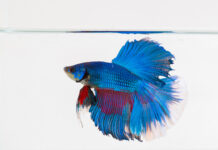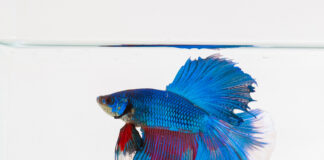If you want to keep your fish healthy and happy, you should clean your used tank and add new water once every week. Cleaning an aquarium doesnât require much time and effort.
If you do it right on time, the algae and other dirt will not build up quickly. But, how will you do it without any knowledge and experience? Luckily, we have come up with steps on how to clean a used fish tank.
More…
What You Will Need
To get everything ready, you have to check out your checklist. Then, make sure that you prep all of the supplies and tools. Hereâs what you have to prepare:
- The water quantity you will need to replace the old water.
- For cleaning the glass tank, you have to get an algae pad
- A bucket that can hold 10 liters of water
- âA siphon-type vacuum for the gravel
- âA filter media, including sponges, cartridges, carbon pockets, etc.
- âA glass cleaner
- â10 percent bleach solution (optional)
- Plastic or metal blade (still optional)
How to Clean the Used Aquarium
Here are some steps to guide you on keeping your used reservoir clean and neat:
Cleaning Each Side of the Tank Using an Algae Pad

You have to wipe the glass and scrub it gently as necessary. It will help get rid of algae attaching to the aquarium glass. If you see patches of residue that are quite hard to remove, then you have to obtain a plastic or razor blade to scrub it off the tank.
Determine How Much Water You Want to Replace
If you want to clean your reservoir on a regular basis and if your fishes are healthy, change at least 20 percent of the water. Do this every once a week. If your fish is sick, you have to replace 25 to 50 percent of the water.
Draw Off the Old Water
Begin the siphoning process and drain off the used water into a bucket or a pail, which can hold five gallons of water. It is ideal to purchase a new bucket and utilize it for just cleaning the tank.
You have to take note that the soap and detergent left in the bucket will be harmful to your fishes. It means that you should not repurpose your laundry pail or bucket that you use for washing clothes or your dishes.
Moreover, you can buy a tank siphon that can attach to the sink. If you already have one of these hoses, you have to know how they work.
These types of siphons usually avoid water spilling from the pail or the bucket. You may also pick the suction and the temperature of the water.
Cleaning the Gravel

You have to shove the vacuum via the gravel. The gravel vacuum can also suck some of the excess food, wastes, and other debris. Also, if you have a weak and sensitive fish, you can put a durable stocking at the tip of the siphon.
Wash Off the Dirty Decorations
Aquarium decorations also need some cleaning. Too much build up of algae will leave a residue. So, you can wash the decorations off and scrub them with an algae pad or a soft-bristled toothbrush.
Do not use soap or detergent because it may cause harm to your fishes. If you think that cleaning the decorations is quite a challenging task, then take them away from the tank. Then, soak them in a 10 percent bleach for at least 15 minutes.
Then, place the boiling water over the decors and allow them to air dry before putting them back in the aquarium. Be mindful of getting rid of the entire bleach because it may kill them.
If your decors have algae all over them, you have to change the water more frequently. Also, give less food to them.
Putting Some Fresh Water

You have to modify the water you draw off from the tank with fresh water at the same temperature of the reservoir. Then, you should have a thermometer that will check the right temperature of the water.
Also, you should maintain the ideal temperature in the tank to keep your fish safe and healthy. Take note that lukewarm water may be too hot to handle for your fish.
Try Adding Tank Salt
A lot of fish species like platies and guppies will extend their lifespan and become healthy when in seawater. So, you may add some salt to the fresh water reservoir to avoid many diseases, including ich.
Observing the Water

You have to wait for several hours and watch out for any cloudiness that retains to dissolve.
That way, it will leave the water clean and clear. There is a lot of clearing agents available on the market, but make sure you avoid using them. If the water is still cloudy, you may have an underlying issue over there, and the agent can mask the problem.
Remember that your fish will also need some space between the tank and the water. That way, you will leave them with enough oxygen and carbon dioxide to breathe normally.
Wiping the Exterior of the Aquarium
Do not forget that you should also scrub the outside of the tank, including its hood, glass, tank cover, and light. Also, you have to take note that ammonia fumes may harm your fishes, so you should use a solution that is safe for the aquatic life.
Replacing the Filter Cartridge Once a Month

You have to ensure that you replace the filter on the tank, so the carbon will not build up. It will cause harm to the fishes if left untouched.
There are no essential bacteria that live in the filter. Most of them are in the gravel, so it will not affect the filtration of the tank.
Moreover, you have to wash the cartridge off once a week when you change the water, especially if it has excess dirt.
But, you do not have to lose all of the bacteria set in your filter by doing so. Lastly, try to rinse the cartridge to substitute replacing it. So, you should still change it per month.
Conclusion
Once your aquarium is clean and you have already replaced the old water, then you are ready to raise your fish. But, you need to make sure that you follow the steps above on cleaning your used tank easily and efficiently.
That way, your fish will be safe from any harm. Plus, it will grow healthy and happy. Remember that happy fish is equal to a happy pet owner.
>>> Read More:
Related Posts:







